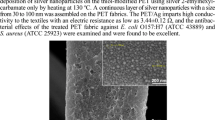Abstract
The ability of inherently conducting polymer (ICP) coated textiles to recover gold metal from aqueous solutions containing [AuCl4]− was investigated. Nylon-lycra, nylon, acrylic, polyester and cotton were coated with a layer of polypyrrole (PPy) doped with 1,5-naphthalenedisulfonic acid (NDSA), 2-anthraquinonesulfonic acid (AQSA) orp-toluenesulfonic acid (pTS). Textiles coated with polyaniline (PAn) doped with chloride were also used. The highest gold capacity was displayed by PPy/NDSA/nylon-lycra, which exhibited a capacity of 115 mg Au/g coated textile, or 9700 mg Au/g polymer. Varying the underlying textile substrate or the ICP coating had a major effect on the gold capacity of the composites. Several ICP coated textiles recovered more than 90% of the gold initially present in solutions containing 10 ppm [AuCl4]− and 0.1 M HCl in less than 1 min. Both PPy/NDSA/nylon-lycra and PAn/Cl/nylon-lycra recovered approximately 60% of the gold and none of the iron present in a solution containing 1 ppm [AuCl4]−, 1000 ppm Fe3+ and 0.1 M HCl. The spontaneous and sustained recovery of gold metal from aqueous solutions containing [AuCl4]− using ICP coated textiles has good prospects as a potential future technology.
Similar content being viewed by others
References
J. Marsden and I. House, “The Chemistry of Gold Extraction”, Chap. 6, p.259, Ellis Horwood, New York, 1992.
J. C. Yannopoulos, “The Extractive Metallurgy of Gold”, Chap. 9, p.171, Van Nostrand Reinhold, New York, 1991.
E. T. Kang, Y. P. Ting, K. G. Neoh, and K. L. Tan,Polymer,34, 4994 (1993).
E. T. Kang, Y. P. Ting, K. G. Neoh, and K. L. Tan,Synthetic Metals,69, 477 (1995).
K. G. Neoh, T. T. Young, N. T. Looi, E. T. Kang, and K. L. Tan,Chem. Mater.,9, 2906 (1997).
K. G. Neoh, K. T. Tan, P. L. Goh, S. W. Huang, E. T. Kang, and K. L. Tan,Polymer,40, 887 (1999).
W. E. Price, S. F. Ralph, and G. G. Wallace,Aust. J. Chem.,54, 615 (2001).
J. Ding, W. E. Price, S. F. Ralph, and G. G. Wallace,J. Appl. Polym Sci. (submitted).
H. H. Kuhn and A. D. Child in “Handbook of Conducting Polymers”, 2nd ed. (T. A. Skotheim, R. L. Elsenbaumer, and J. R. Reynolds Eds.), Marcel Dekker, New York, 1998.
J. Ding, V. Misoska, W. E. Price, S. F. Ralph, G. Tsekouras, and G. G. Wallace,Synthetic Metals,135–136, 35 (2003).
Author information
Authors and Affiliations
Corresponding author
Rights and permissions
About this article
Cite this article
Tsekouras, G., Ralph, S.F., Price, W.E. et al. Gold recovery using inherently conducting polymer coated textiles. Fibers Polym 5, 1–5 (2004). https://doi.org/10.1007/BF02875487
Received:
Revised:
Accepted:
Issue Date:
DOI: https://doi.org/10.1007/BF02875487




